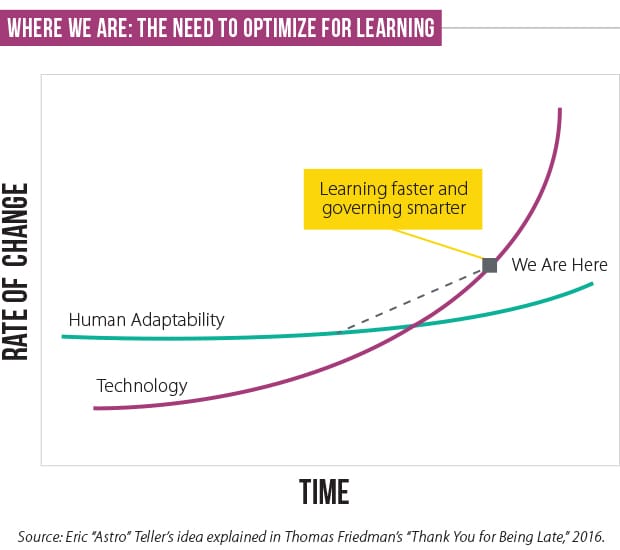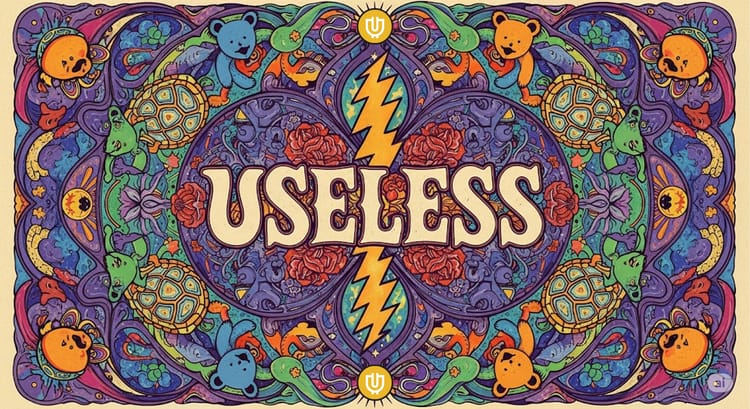We can no longer keep up

In Thank You For Being Late, Thomas Friedman recounts a conversation he had with Eric “Astro” Teller, the CEO of Google X, Google’s moonshot lab for experimental technologies. During this conversation, Teller suggested that somewhere around 2012, we crossed a critical inflection point—one where technology’s acceleration, fueled by Moore’s Law, outpaced our collective ability to adapt.
Think about it: until that point, we humans were keeping up with technology. Sure, it was a wild ride—we went from personal computers to ATMs, from cell phones to the World Wide Web. These were revolutionary, but we could wrap our heads around them. Society could keep pace. But then, as Moore’s Law continued its relentless drumbeat—computers doubling in power every couple of years—we hit a wall. Suddenly, things weren’t just getting faster, they were getting exponentially more complex. Teller pointed out that this moment around 2012 marked the shift when “humans could no longer keep up.”

And this isn’t just about hardware. It’s about the data explosion, the rise of mobile computing, the emergence of cloud storage and AI—technologies that interact with each other in complex, compounding ways. Instead of linear progress, we were now dealing with combinatorial innovation. It’s like we were walking along a calm, predictable shoreline, and suddenly we were swept out into a tidal wave of exponential change.
This insight is one of the reasons I founded Crypto Strategy Group (CSG). Today, we’re not just grappling with Moore’s Law—we’re also trying to make sense of blockchain technology and artificial intelligence, two massive shifts that have joined the wave. Both AI and crypto are revolutionary, but they’re also bewildering. The very nature of these technologies means they’re not just tools we can easily pick up and use. They require a rethinking of how we approach trust, data, ownership, and intelligence.
AI and the New Complexity
Let’s talk about AI for a moment. Artificial intelligence isn’t just a more powerful version of the computer—it’s a fundamentally different way of creating, interpreting, and applying information. Until recently, we thought of machines as tools for humans: calculators, spreadsheets, word processors. Now, with machine learning and generative AI, we’re building systems that don’t just assist us—they learn from us, adapt, and sometimes even surprise us.
This is thrilling but also deeply unsettling. AI introduces layers of complexity we haven’t fully digested. Think of neural networks processing billions of parameters to generate realistic text or images. Or consider the implications of automated decision-making in areas like healthcare, finance, and criminal justice. The old rules no longer apply. We can’t just plug AI into our existing workflows and expect things to improve. We need new frameworks for understanding and integrating this technology responsibly.
Crypto: Trustless Systems and the Redefinition of Ownership
Now layer on top of that the rise of blockchain and cryptocurrencies. Much like AI, blockchain challenges our assumptions about how the world works. Traditionally, we’ve relied on trusted intermediaries—banks, governments, notaries—to manage ownership, contracts, and transactions. Blockchain flips that on its head. Suddenly, we’re talking about trustless systems, where code replaces institutions, and consensus mechanisms replace boardrooms.
For business owners and individuals alike, this is both liberating and terrifying. It promises decentralization and transparency but demands a level of technical literacy and risk tolerance many aren’t prepared for. The crypto landscape is littered with stories of meteoric rises and catastrophic crashes—sometimes in the same week. For every success story, there are cautionary tales of scams, hacks, and mismanaged protocols.
This complexity—combined with the rapid pace of innovation—is why so many feel left behind. The narrative has shifted from “I need to learn how to use a computer” to “I need to understand how AI-generated content, smart contracts, and tokenomics intersect in a global, decentralized economy.”
I've been living and breathing AI and crypto since around 2018 and even being in it full time I have to work at it to keep up. This is only the beginning...now I need to make an AI version of myself.
